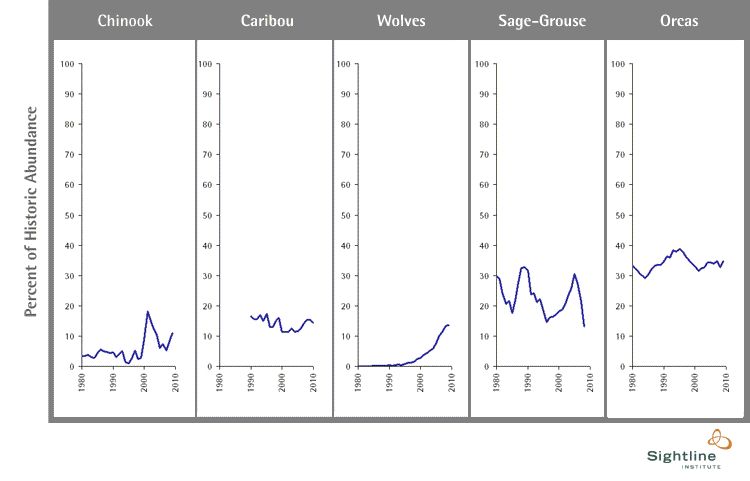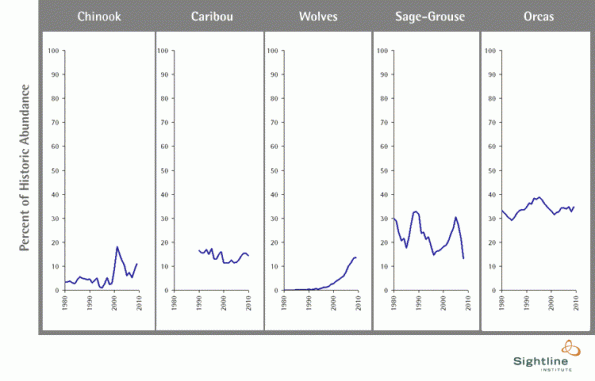According to Sightline’s Cascadia Scorecard—a regional progress report for the Northwest—several of the region’s wildlife icons are still at risk. The Scorecard’s wildlife indicator measures current populations of salmon, orcas, wolves, caribou, and sage-grouse compared to their historical abundance. Overall, gains for salmon, orcas, and wolves outweighed declines in caribou and sage-grouse, pushing the index to an all-time high. Still, more progress is needed.
Northwest Wildlife Icons Still at RiskBrief summary: Mixed results for five species
- In 2009, more than 300,000 chinook passed the Columbia River’s Bonneville Dam—a 29 percent increase over the previous year.
- Puget Sound orcas experienced a baby boom, adding five new orcas last year—welcome news after a decline in the previous year.
- Despite the first recreational wolf hunts in Idaho and Montana last year, wolf populations continued to grow, albeit at a slower rate than the years before.
- In 2010, biologists counted only 43 animals in the Selkirk caribou herd, 3 fewer than the previous two counts.
- Oregon’s greater sage-grouse experienced a precipitous decline in 2008. It’s still unclear whether the drop was due to natural population cycles or something else.
Also see:
- For links to charts showing the abundance of the five indicator species and other Northwest species, see Wildlife Abundance for Five Indicator Species.
- For maps showing current and historic ranges of some of the Northwest’s wildlife species, see Maps: Current and Historic Wildlife Ranges.
Details about how the five species are faring
These species serve as rough proxies for the natural wealth that northwesterners have inherited, and for our stewardship of that inheritance. If the region’s forests, deserts, rivers, and marine waters are healthy and thriving, then Cascadia’s salmon, orcas, wolves, caribou, and sage-grouse will thrive too. If not, these creatures will dwindle and disappear.
For the region’s first human inhabitants, Cascadia was defined by its wildlife. The spectacularly abundant salmon played a central role in First Nations’ cultures, while orcas, wolves, and countless other species populated tribal myths.
Today those creatures’ abundance is severely reduced (see charts that track abundance of wildlife species in Cascadia). Even so, Cascadia’s native species remain not only a source of wonder and fascination, but also an economic engine for tourism, fisheries, and other industries. Just as important, the abundance of the region’s wildlife offers insights into the health of the natural ecosystems that support and enrich our lives.
SALMON
Each year, the chinook (or “king”) salmon journey up the Columbia River, past dams, deserts, cities, and farms, to spawn in their natal streams. In 2009, more than 300,000 chinook passed the Columbia River’s Bonneville Dam, 146 miles upstream from the river’s mouth on the Pacific Ocean.
It was a strong showing for the fish: a 29 percent increase over the previous year and the second consecutive year of increasing numbers. Yet annual population fluctuations send murky messages about the health of the fish. Chinook counts vary by about 40 percent a year on average, mostly due to natural population dynamics. Only long-term monitoring can reveal meaningful trends in the population. And last year’s fish count, while good by the standards of the past 25 years, is still a very poor showing in historical terms: less than 11 percent of historical abundance. And the true story is even bleaker: wild salmon probably return at less than 3 percent of their former numbers. The rest of the returning salmon are hatchery-raised fish, whose numbers are far less meaningful as signals of the region’s ecological health.
ORCAS
The “southern resident” orcas live much of their lives in the inland marine waters of Puget Sound and the Georgia Strait. After a worrisome seven-year decline starting in 1995, the number of southern resident orcas began to increase.
After a population dip in 2008, the orcas welcomed five new calves in 2009. Many orca experts say that an abundance—or shortage—of salmon is the biggest factor determining what happens to the southern residents, highlighting the important connections between two of the Northwest’s iconic species. (Click for more information about orca population trends and recovery efforts.)
WOLVES
The rapid increase in Rocky Mountain wolves represents a relative bright spot for the region’s wildlife—though population growth slowed in 2009 due to new recreational hunts in Montana and Idaho and increased conflicts with domesticated animals. Wolf numbers are still at perhaps 10 percent of their levels prior to European contact.
Wolves had been systematically eradicated from the western United States by the middle of the twentieth century. (Click for map of historic and modern wolf range.) But in the mid-1990s, federal officials reintroduced a few dozen gray wolves to the wilderness of central Idaho and to Yellowstone National Park. Since then the wolves have flourished, expanding their range and number faster than even the most optimistic projections. At the end of 2009, biologists estimated that there were more than 1,706 wolves in the US Rockies. (Idaho, Montana, Washington and Oregon, whose wolf numbers are now counted by the Scorecard, boasted some 1,386 wolves.) These populations may be near their peak, as wolves have likely recolonized most of the good habitat available to them.
Today, pioneer wolves originating from both Idaho and British Columbia are returning to their historic range in Oregon and Washington. In 2009, federal biologists counted 14 wolves in Oregon and 5 in Washington, though it remains to be seen how quickly they will repopulate that territory.
CARIBOU
 The most endangered large mammal in North America, mountain caribou retain only the barest foothold south of the Canadian border, and are in danger of extirpation. In the remote Selkirk Mountains of northeast Washington, northern Idaho, and southern British Columbia, one caribou herd persists; the Scorecard includes their precarious numbers as a proxy for the populations of mountain caribou across the northern regions. (Click for map of historic and modern caribou range.)
The most endangered large mammal in North America, mountain caribou retain only the barest foothold south of the Canadian border, and are in danger of extirpation. In the remote Selkirk Mountains of northeast Washington, northern Idaho, and southern British Columbia, one caribou herd persists; the Scorecard includes their precarious numbers as a proxy for the populations of mountain caribou across the northern regions. (Click for map of historic and modern caribou range.)
In 2010, biologists counted only 43 animals in the Selkirk caribou herd, 3 fewer than the previous two years. But it’s not clear whether this represents a one-year decline or a more serious problem for the tiny population. The caribou are threatened on several sides. Clearcut logging has reduced the old growth trees that host the lichen that the caribou depend on for food. People, especially those on snowmobiles, startle the animals in winter and cause them to expend scarce calories to flee through deep snow. And predators such as cougars traverse the hardened snowmobile tracks into the herd’s winter range–travel that the predators could not otherwise manage.
SAGE-GROUSE
 The greater sage-grouse, a desert-dwelling bird known for its astonishing breeding displays, is one of the best indicators of the health of the Northwest’s interior sage deserts. As its name implies, the bird depends on relatively intact sagebrush landscapes, much of which has been degraded by ranching, fencing, invasive species, mining, and off-road vehicles.
The greater sage-grouse, a desert-dwelling bird known for its astonishing breeding displays, is one of the best indicators of the health of the Northwest’s interior sage deserts. As its name implies, the bird depends on relatively intact sagebrush landscapes, much of which has been degraded by ranching, fencing, invasive species, mining, and off-road vehicles.
When Lewis and Clark traveled through the Columbia Basin, they observed sage-grouse in great numbers. Today, only two small remnant populations survive in eastern Washington. But in Oregon, where sage habitat is remoter and more intact, sage-grouse numbers are relatively stable. Recent years, however, have revealed worrisome declines. Today, biologists estimate that only about 22,000 of the birds remain in Oregon–the lowest number ever recorded, and less than 15 percent of the species’ historical abundance in that state. (Click for map of historic and current sage-grouse range.)









